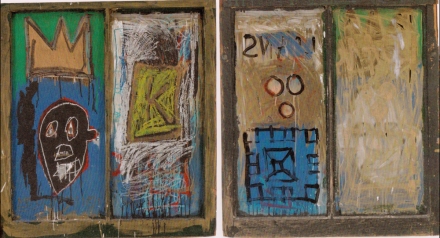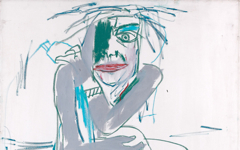Basquiat’s Crowns (1981-2)
A crown appears frequently in the early work of Jean-Michel Basquiat signaling his ambition and understanding of art history. Many artists used their monarchs to symbolize their own majestic powers and Basquiat, lacking one, continued the tradition in his own way. Besides, Basquiat was ambitious and out to become king of the pack. One friend who knew him early on wrote: “He could walk into a thrift store with five bucks and come out looking like a king. In fact he basically behaved like a king who had accidentally switched lives with an identical pauper.”1 Let’s take a look at Red Kings, painted in 1981 when he was twenty-one.
The left-hand side of this double-portrait represents Basquiat himself crowned. We know that because in the four blank empty spots, indicating eyes, nose and mouth, the letters B, Q and S appear, enough to suggest his name: BASQUIAT.2
The portrait on the right-hand side is a skull.....
Click next thumbnail to continue
..........which strongly suggests one of Picasso's last self-portraits, drawn nine years earlier. Picasso and Warhol were the two artists Basquiat most admired as a teenager and he knew their work well.3 Red Kings thus places Basquiat's portrait as king next to Picasso's portrait as king, a succession he intended to fulfil.
Click next thumbnail to continue
He did something similar, placing his head next to Warhol's, a few hours after first properly meeting the American artist.
Click next thumbnail to continue
In another Crown painting from 1981, a black face makes Basqiat's self-image more apparent. The crown itself, though, has been reduced to only three points which, given Basquiat's fondness for letters, suggests a W for Warhol. Basquiat had Warhol in his head a year before meeting him.
Click next thumbnail to continue
In a third painting from 1981, dated Christmas Day, three crowned heads appear along the top. They resemble paintings on a wall. Two are black with a 3-point crown, the other ghostly white like the anemic-looking, bleached blonde Warhol. His W is fused into his head. The two artists have become the three kings though the haloed figure of Christ, further down on the left, is black. This suggests that Warhol may be one of the three kings but it is Jean-Michel who is Christ born Christmas Day.
See conclusion below
The apparent competition with Warhol and Picasso is not an exterior happening nor an account of their own places in history. Instead as in all art, the allusions are metaphorical. Basquiat's own mind has assimilated aspects of Warhol or Picasso through intimate knowledge of their work.3 Each of those heads is Basquiat. The Christ-figure, too, is not the historic Jesus but the divine spark in each of us which, if nurtured, will make us "Christ". Basquiat had no particular religion but the esoteric idea that we can each strive to become perfect, pure or wholly divine is such an important theme in poetic art and literature, regardless of which strain of the Inner Tradition is followed, that the sensitive Basquiat could not have missed it. And, once we attain perfection, we are re-born like Christ as an infant (metaphorically, of course.)
More Works by Basquiat
Notes:
1. Glenn O'Brien, "Who was that masked man?" in Basquiat (Ostfildern: Hatje Cantz Verlag) 2010, p.II
2. There is a strange tradition in art whereby not all letters are needed to indicate a name, only a handful.
3. Basquiat did not meet Warhol until the next year, 1982
3. O'Brien, “Basquiat and the New York Scene 1978-82” in Basquiat, ibid., p. VIII
Original Publication Date on EPPH: 20 Nov 2010. | Updated: 0. © Simon Abrahams. Articles on this site are the copyright of Simon Abrahams. To use copyrighted material in print or other media for purposes beyond 'fair use', you must obtain permission from the copyright owner. Websites may link to this page without permission (please do) but may not reproduce the material on their own site without crediting Simon Abrahams and EPPH.








